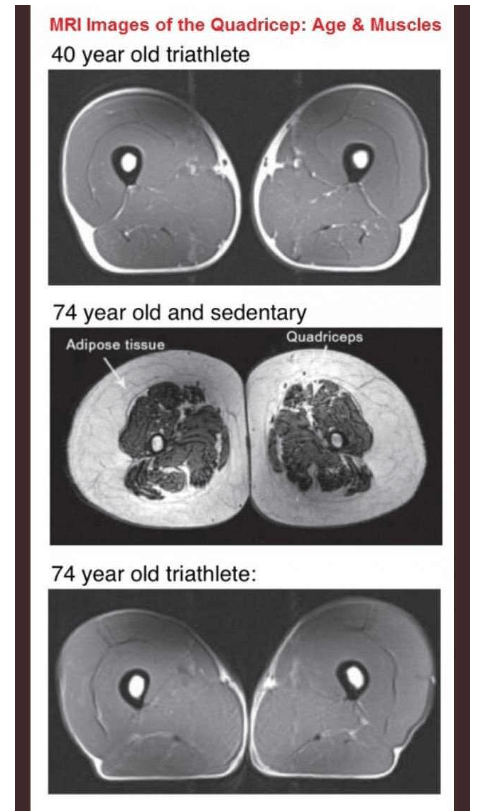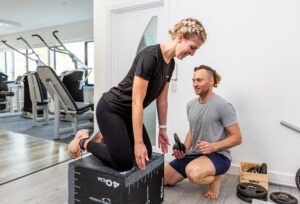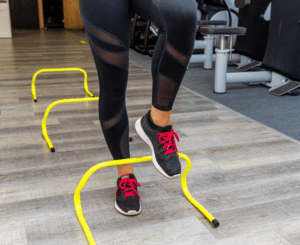What is sarcopenia?
Sarcopenia is the progressive loss of skeletal muscle mass and function that occurs naturally as one ages. This process can begin from as early as 30 years old and, in extreme cases, can result in as much as a 1% loss in muscle each year, although from the age of 60-75, this rate of muscle loss accelerates even faster. Potentially, this can accumulate to 50% reduction in muscle mass by 80 years old compared to in early adulthood.
Since total muscle mass is the largest determinant of whole-body strength and power, sarcopenia is often accompanied by a disproportionately faster rate of decrease in strength and power development. This can often present itself as finding daily tasks harder than before – for example, opening jars, climbing the stairs, or standing from a seated position. Walking speed also tends to decrease over time. Eventually, this can lead to a lack of independence, increased frailty and risk of falls or fractures, and can also promote insulin resistance and metabolic diseases. Sadly, this loss of muscle is invariably accompanied by a relative increase in fat tissue, which is also detrimental to health. Overall, sarcopenia is associated with longer recovery times from illness, infection, and injury, leading to longer and more frequent hospital stays. It is therefore not surprising, then, that 50% of men, and 31% of women in nursing homes are diagnosed with sarcopenia.
Am I at risk of sarcopenia?
Since sarcopenia affects muscle tissue, it is important to consider muscle mass, strength, and function to assess one’s risk of developing sarcopenia.
An important first step would be to calculate one’s muscle mass. The gold-standard method for this would involve an MRI or DEXA scan to accurately measure total body composition. However, cheaper and more convenient methods do exist! Many digital bathroom weighing scales, as well as our body composition scales on site, now have a bioelectrical impedance (BIA) function. After stepping on these scales with bare feet, a very small electrical signal can be sent through the body. The speed at which this signal travels through the fat and muscle tissues can then be used to accurately estimate the total levels of fat and muscle in the body at any given time. These scales may be susceptible to inaccuracies; for example, any metal implants in the body may skew the readings. However, they are excellent for monitoring trends. For the best results, regular measurements should be taken under the same standard conditions. A popular example may be every Sunday morning, straight after waking up. Being aware of your total muscle mass is the first step – from there it is a case of ensuring that this number doesn’t decrease significantly. It is also possible to increase one’s levels of lean tissue under the correct conditions!
It may also be beneficial to perform some tests with the help of a health care professional to assess your current strength and quality of movement. Popular examples that we use at tops:health include grip strength tests, walking speed tests, and a timed up-and-go test, which assesses one’s ability to stand from a chair, walk three metres and sit down again as quickly as possible. These tests are insightful because they have well-known optimal scores, based on your sex and age. Knowing how one compares to these can provide an insight into any areas which require focus and improvement.
How can I prevent or delay sarcopenia?
Whilst there are dietary interventions which can help with the onset of sarcopenia, such as increasing one’s protein intake, the most effective method for preventing, delaying, or minimizing sarcopenia is regular physical activity. Resistance training in particular will increase strength and power, and also contribute to the maintenance of muscle mass in the body. This is not just limited to the use of free weights such as dumbbells – the use of gym machines, resistance bands, and bodyweight training such as yoga or Pilates also has a beneficial effect. Ideally, one should perform these types of exercises on the major muscle groups at least 2 separate days each week, in line with guidelines from the UK Government on physical activity for adults. However, the benefits of resistance training go well beyond gaining muscle. Regular training can also lead to a higher resting metabolic rate, lower levels of fat tissue, preserved or improved bone mineral density, reduced blood pressure, and better blood sugar control.
To summarise
Sarcopenia is a natural part of the aging process, but this doesn’t mean that we should accept it. Loss of muscle is associated with a loss of independence and an increased risk of disease. Incorporating regular resistance training and seeking the help of an exercise specialist can help to prevent sarcopenia and maintain health. It is important to remember that consistency is king – building and maintaining good habits, such as regular physical activity, will greatly improve quality of life at all ages. You are never too young to start!



